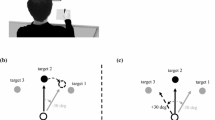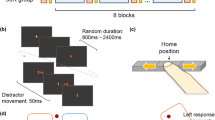Abstract
The present study compared single and dual adaptation to visuomotor rotations in different cueing conditions. Participants adapted either to a constant rotation or to opposing rotations (dual adaptation) applied in an alternating order. In Experiment 1, visual and corresponding postural cues were provided to indicate different rotation directions. In Experiment 2, either a visual or a postural cue was available. In all cueing conditions, substantial dual adaptation was observed, although it was attenuated in comparison to single adaptation. Analysis of switching costs determined as the performance difference between the last trial before and the first trial after the change of rotation direction suggested substantial advantage of the visual cue compared to the postural cue, which was in line with previous findings demonstrating the dominance of visual sense in movement representation and control.





Similar content being viewed by others
Notes
A further class of abstract instructional cues (Imamizu et al., 2007) will not be discussed here.
References
Bock, O., Schneider, S., & Bloomberg, J. (2001). Conditions for interference versus facilitation during sequential sensorimotor adaptation. Experimental Brain Research, 138(3), 359–365.
Bock, O., Worringham, C., & Thomas, M. (2005). Concurrent adaptations of left and right arms to opposite visual distortions. Experimental Brain Research, 162(4), 513–519.
Brainard, D. H. (1997). The Psychophysics Toolbox. Spatial Vision, 10, 433–436.
Galea, J. M., & Miall, R. C. (2006). Concurrent adaptation to opposing visual displacements during an alternating movement. Experimental Brain Research, 175(4), 676–688.
Gandolfo, F., Mussa-Ivaldi, F., & Bizzi, E. (1996). Motor learning by field approximation. Proceedings of the National Academy of Sciences, 93(9), 3843–3846.
Gordon, A. M., Westling, G., Cole, K. J., & Johansson, R. S. (1993). Memory representations underlying motor commands used during manipulation of common and novel objects. Journal of Neurophysiology, 69(6), 1789–1796.
Haruno, M., Wolpert, D. M., & Kawato, M. (2001). MOSAIC Model for Sensorimotor Learning and Control. Neural Computation, 13, 2201–2220.
Hegele, M., & Heuer, H. (2010). Implicit and explicit components of dual adaptation to visuomotor rotations. Consciousness and Cognition, 19(4), 906–917.
Heuer, H., & Hegele, M. (2011). Generalization of implicit and explicit adjustments to visuomotor rotations across the workspace in younger and older adults. Journal of Neurophysiology, 106(4), 2078f Neur.
Imamizu, H., Kuroda, T., Yoshioka, T., & Kawato, M. (2004). Functional magnetic resonance imaging examination of two modular architectures for switching multiple internal models. The Journal of Neuroscience, 24(5), 1173–1181.
Imamizu, H., Sugimoto, N., Osu, R., Tsutsui, K., Sugiyama, K., Wada, Y., et al. (2007). Explicit contextual information selectively contributes to predictive switching of internal models. Experimental Brain Research, 181(3), 395–408.
Kagerer, F. A., Contreras-Vidal, J., & Stelmach, G. E. (1997). Adaptation to gradual as compared with sudden visuo-motor distortions. Experimental Brain Research, 115(3), 557–561.
Karniel, A., & Mussa-Ivaldi, F. A. (2002). Does the motor control system use multiple models and context switching to cope with a variable environment? Experimental Brain Research, 143(4), 520–524.
Kleiner, M., Brainard, D., & Pelli, D. (2007). What’s new in psychotoolbox-3? Perception, 36 ECVP Abstract Supplement.
Krakauer, J. W. (2009). Motor learning and consolidation: the case of visuomotor rotation. Progress in Motor Control, 629, 405–421.
Krakauer, J. W., Ghez, C., & Ghilardi, M. F. (2005). Adaptation to Visuomotor Transformations: Consolidation, Interference, and Forgetting. The Journal of Neuroscience, 25(2), 473–478.
Krakauer, J. W., Ghilardi, M. F., & Ghez, C. (1999). Independent learning of internal models for kinematic and dynamic control of reaching. Nature Neuroscience, 2, 1026–1031.
Krakauer, J. W., Pine, Z. M., Ghilardi, M. F., & Ghez, C. (2000). Learning of visuomotor transformations for vectorial planning of reaching trajectories. The Journal of Neuroscience, 20(23), 8916–8924.
Krouchev, N. I., & Kalaska, J. F. (2002). Context-dependent anticipation of different task dynamics: Rapid recall of appropriate motor skills using visual cues. Journal of Neurophysiology, 89(2), 1165–1175.
Ladwig, S., Sutter, C., & Müsseler, J. (2012). Crosstalk between proximal and distal action effects during tool use. Zeitschrift für Psychologie/Journal of Psychology, 220, 10–15.
Larssen, B. C., Ong, N. T., & Hodges, N. J. (2012). Watch and Learn: Seeing is Better than Doing when Acquiring Consecutive Motor Tasks. PLoS ONE, 7(6), e38938.
Lee, J. Y., & Schweighofer, N. (2009). Dual adaptation supports a parallel architecture of motor memory. The Journal of Neuroscience, 29(33), 10396–10404.
Massen, C. (2012). Die Planung und kognitive Repräsentation von Handlungen mit Werkzeugen [Planning and cognitive representation of actions with tools]. Psychologische Rundschau, 63(2), 79–91.
Mechsner, F., Kerzel, D., Knoblich, G., & Prinz, W. (2001). Perceptual basis of bimanual coordination. Nature, 414(6859), 69–72.
Miall, R. C., Jenkinson, N., & Kulkarni, K. (2004). Adaptation to rotated visual feedback: a re-examination of motor interference. Experimental Brain Research, 154(2), 201–210.
Miall, R. C., & Wolpert, D. M. (1996). Forward models for physiological motor control. Neural Network, 9(8), 1265–1279.
Müsseler, J., & Sutter, C. (2009). Perceiving one’s own movements when using a tool. Consciousness and Cognition, 18(2), 359–365.
Oldfield, R. C. (1971). The assessment and analysis of handedness: the Edingburgh inventory. Neuropsychologia, 9, 97–113.
Pelli, D. G. (1997). The VideoToolbox software for visual psychophysics: Transforming numbers into movies. Spatial Vision, 10, 473–442.
Rand, M. K., Wang, L., & Müsseler, J. (2013). Vision and proprioception in action monitoring by young and older adults. Neurobiology of Aging, 34(7), 1864–1872.
Rao, A., & Shadmehr, R. (2001). Contextual cues facilitate learning of multiple models of arm dynamics. Society for Neuroscience Abstracts, 302(4).
Shadmehr, R., & Holcomb, H. H. (1999). Inhibitory control of competing motor memories. Experimental Brain Research, 126(2), 235–251.
Shadmehr, R., & Mussa-Ivaldi, F. A. (1994). Adaptive representation of dynamics during learning of a motor task. The Journal of Neuroscience, 14(5), 3208–3224.
Sutter, C., Sülzenbrück, S., Rieger, M., & Müsseler, J. (2013). Limitations of distal effect anticipation when using tools. New Ideas in Psychology.
Tong, C., Wolpert, D. M., & Flanagan, J. R. (2002). Kinematics and dynamics are not represented independently in motor working memory: evidence from an interference study. The Journal of Neuroscience, 22(3), 1108.
Wang, L., & Müsseler, J. (2012). Generalization of visuomotor adaptation depends on the spatial characteristic of visual workspace. Experimental Brain Research, 223(3), 253–365.
Wang, L, Rand, M. K., & Müsseler, J. (2013). Spatial realignment in sensorimotor adaptation: Taking the efficiency into account. Journal of Experimental Psychology: Human Perception and Performance. Online first.
Wigmore, V., Tong, C., & Flanagan, J. R. (2002). Visuomotor rotations of varying size and direction compete for a single internal model in a motor working memory. Journal of Experimental Psychology: Human Perception and Performance, 28(2), 447.
Wolpert, D. M., Ghahramani, Z., & Jordan, M. I. (1995). An internal model for sensorimotor integration. Science, 269(5232), 1880–1882.
Woolley, D. G., Tresilian, J. R., Carson, R. G., & Riek, S. (2007). Dual adaptation to two opposing visuomotor rotations when each is associated with different regions of workspace. Experimental Brain Research, 179(2), 155–165.
Acknowledgments
We wish to thank Pia Elisabeth Weber and Florian Bade for carrying out the experiments. We also wish to thank Jens Tiggelbeck for fruitful discussions. This research was supported by a grant from the Deutsche Forschungsgemeinschaft to the J. Müsseler (DFG MU 1298/9). Correspondence concerning this manuscript should be addressed to the first author at the Department of Work and Cognitive Psychology, RWTH Aachen University, Jägerstr. 17-19, 52066 Aachen, Germany. Email: lei.wang@psych.rwth-aachen.de.
Author information
Authors and Affiliations
Corresponding author
Rights and permissions
About this article
Cite this article
Wang, L., Müsseler, J. Concurrent adaptation to opposite visual distortions: impairment and cue. Psychological Research 78, 453–464 (2014). https://doi.org/10.1007/s00426-013-0500-1
Received:
Accepted:
Published:
Issue Date:
DOI: https://doi.org/10.1007/s00426-013-0500-1




